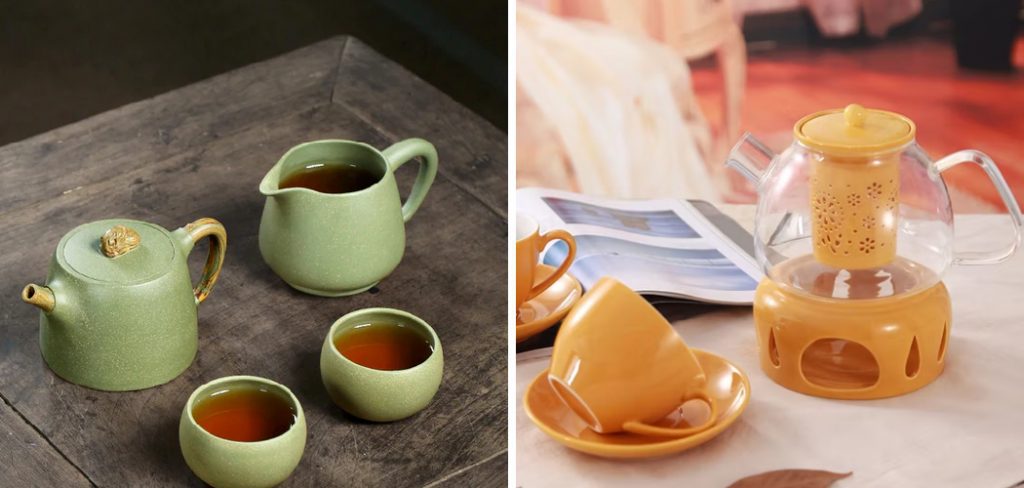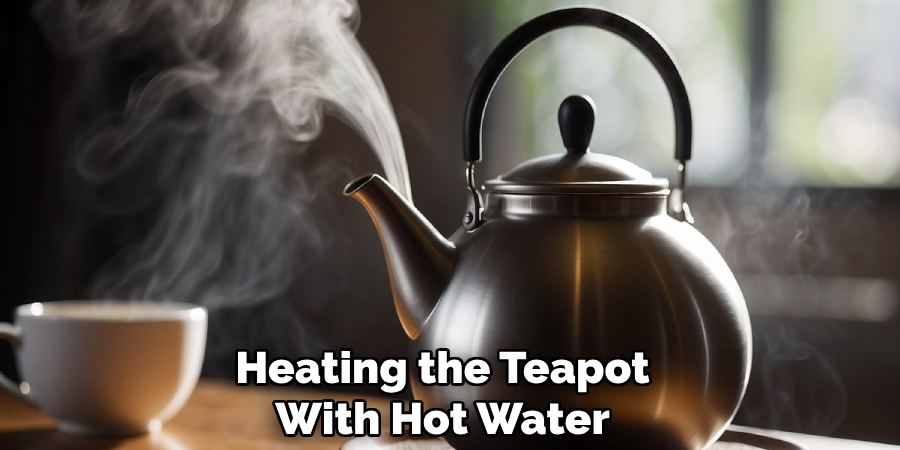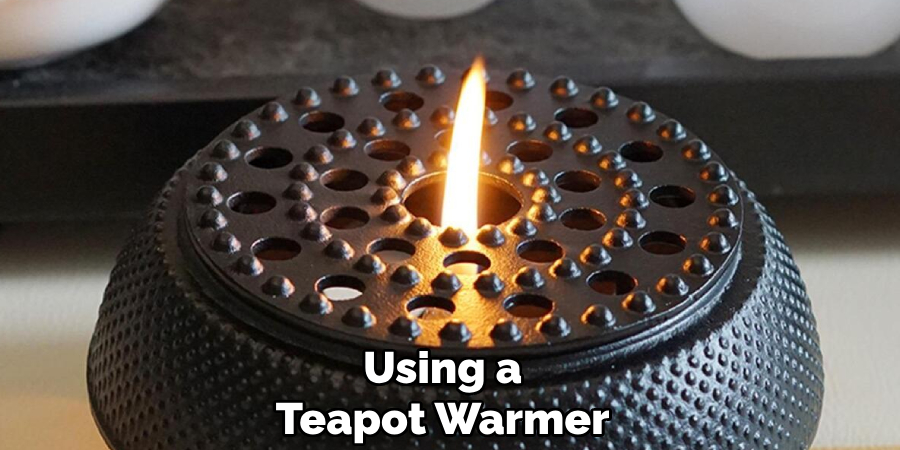Properly heating a ceramic teapot is essential in brewing the perfect cup of tea. Many tea enthusiasts may not realize that preheating their teapot can make a significant difference in maintaining the temperature of the tea and enhancing its flavor. This simple step ensures a consistent and warm brew by preventing the drastic temperature drop that can occur when hot tea is poured into a cold pot.

Ceramic teapots are particularly advantageous as they retain heat longer than other materials, allowing the tea to stay warm for extended periods while preserving its rich taste. This article aims to provide a comprehensive, step-by-step guide on how to heat a ceramic teapot safely and effectively. Whether you are a seasoned tea drinker or just beginning your tea journey, this guide will offer practical methods and valuable tips for achieving the best results.
Why You Should Heat a Ceramic Teapot
Heating a ceramic teapot before brewing tea is essential to enhance the overall tea experience. One primary reason to preheat your teapot is to maintain the temperature of the tea for longer periods. A warm teapot prevents the brew from cooling too quickly, ensuring that each cup is served at the ideal drinking temperature. This enhances the sensory experience and preserves the full depth of flavors in the tea.
Additionally, pre-heating a ceramic teapot plays a significant role in improving the flavor of your tea. When a teapot is cold, pouring hot water directly into it can cause a sudden drop in temperature, disrupting the brewing process. This can result in weaker or unevenly extracted flavors. Warming the teapot beforehand creates a stable brewing environment, allowing the tea leaves to steep thoroughly and release their rich, nuanced taste.
Finally, heating your ceramic teapot helps maintain its quality and longevity. Sudden temperature changes, known as thermal shock, can lead to cracks or other damage in your teapot. Proper heating minimizes this risk, protecting your cherished teapot and ensuring it can be enjoyed for years to come.
Materials and Tools Needed
Certain materials and tools are essential to properly heat and use a ceramic teapot. Below is a list of items that will ensure an efficient tea-making process while preserving the quality of your teapot:
Essential Tools for Heating the Ceramic Teapot
- Hot Water: Necessary for warming the teapot before brewing. This step helps stabilize the brewing temperature for optimal steeping.
- Kettle or Pot for Boiling Water: A reliable kettle or pot is needed to boil water for both warming the teapot and brewing the tea.
- Optional Tools: A teapot warmer or an electric tea kettle with temperature control can be used for precision and maintaining the desired temperature during serving.
Additional Supplies for Serving
- Tea Leaves or Tea Bags: Depending on your brewing preference, select high-quality loose-leaf tea or tea bags for the best flavor.
- Tea Infuser: If using loose-leaf tea, a tea infuser can be helpful for easy brewing and cleanup.
These tools and materials ensure a seamless tea preparation process, from heating the ceramic teapot to serving the perfect cup of tea. Investing in proper equipment enhances the tea experience while safeguarding the longevity of your teaware.
How to Heat a Ceramic Teapot: Heating the Teapot with Hot Water
Preheating the teapot is essential to ensure an optimal tea-brewing experience. This method prepares the teapot to retain the correct temperature for steeping the tea.
Step 1: Boil Water
Bring water to a boil in a kettle or pot. Once the water reaches a rolling boil, cool slightly for a few seconds. This prevents the ceramic teapot from experiencing thermal shock, which could potentially damage the material.

Step 2: Pour Hot Water Into the Teapot
Carefully pour the hot water into the empty ceramic teapot, filling it halfway or more. This step allows the heat to spread evenly through the walls of the teapot. Proper warming ensures that when the tea is brewed, the water remains at an ideal temperature to enhance flavor extraction.
Step 3: Discard the Water
After letting the hot water sit for two to three minutes, carefully pour it out of the teapot. Be cautious during this step, as the water will still be very hot. Your teapot is now properly preheated and ready to receive the tea leaves or bags, ensuring the brewing process delivers the best taste and aroma.
By following these steps, you not only preserve the integrity of the tea but also elevate the overall drinking experience, as the temperature consistency creates a better environment for steeping.
Using a Teapot Warmer
If you’d like to keep your tea at the perfect temperature and elevate your tea brewing experience, using a teapot warmer is an effective and elegant solution. This method not only helps maintain the tea’s warmth during service but can also be used to warm the teapot prior to brewing gently.
Step 1: Set Up the Teapot Warmer
Begin by placing a small candle or an electric teapot warmer underneath your ceramic or heat-resistant teapot. Ensure the warmer is on a steady, heat-safe surface to prevent accidents or spills during use. The placement should allow for even heat distribution to the base of the teapot.
Step 2: Heating the Teapot
Light the candle or turn on the electric warmer, and allow the gentle heat to warm up the teapot gradually. This process typically takes around 10–15 minutes, depending on the material and thickness of the teapot. Warming the teapot this way ensures the vessel retains heat effectively, which benefits the tea’s flavor and helps maintain its aromatic profile.

Step 3: Adjusting Temperature
Once the teapot is warm, you can continue to use the warmer to maintain a consistent tea temperature throughout the brewing and serving process. This is especially useful for long tea services or if you’re enjoying tea in a colder environment. Adjust the warmer to avoid overheating, ensuring your tea remains at an ideal drinking temperature.
Following this technique enhances the tea experience, allowing each cup to stay warm and flavorful while demonstrating care and attention to detail in your tea preparation.
Using the Oven
Step 1: Preheat the Oven
Preheat your oven to a low temperature, approximately 200°F (93°C). This gentle heat ensures the teapot warms evenly without causing any damage or overheating.
Step 2: Place the Teapot in the Oven
Carefully place your ceramic teapot inside the oven without the lid. Allow it to heat for about 10–15 minutes gently. Monitor the time and temperature to avoid overheating or damaging the teapot.
Step 3: Remove and Discard Water
Using oven mitts, carefully take the teapot out of the oven once it has been warmed. If you used water to preheat it, pour out any remaining liquid immediately. The warmed teapot is now perfectly ready to brew your tea, helping maintain the ideal serving temperature.
By utilizing the oven method, you prepare your teapot uniformly for an enjoyable tea brewing process, ensuring that every cup remains warm and aromatic.

Using Hot Tap Water
Step 1: Run Hot Water in the Sink
Run hot water from the tap at a comfortable temperature, ensuring it is warm enough to heat the teapot but not boiling. Boiling water can potentially cause cracks or damage to the ceramic, so maintain a safe heat level.
Step 2: Place the Teapot Under the Running Water
Hold the teapot under the stream of running hot water for around 1–2 minutes. Ensure that the exterior and interior surfaces of the teapot are evenly warmed. This step helps prepare the teapot for optimal tea brewing by gently raising its temperature.
Step 3: Drain and Use
Drain out any remaining water once the teapot feels uniformly warm to the touch. The teapot is now ready to be used for tea preparation. While this method is quick and efficient, it may not retain heat as effectively as some other warming techniques, making it ideal when time is limited.
Tips and Precautions for Heating Ceramic Teapots
Avoid Thermal Shock
Never pour boiling water directly into a cold ceramic teapot, as this sudden temperature change can cause it to crack or break. To prevent thermal shock, always preheat the teapot gradually using one of the recommended methods mentioned earlier. This ensures a gentle temperature transition, preserving the integrity of the ceramic material.
Using Proper Heat Sources
When heating your ceramic teapot in an oven or on a warmer, use only low to medium heat settings. High temperatures can lead to cracking or damage over time. Avoid direct flame exposure unless the ceramic is specifically designed to withstand such heat. Following this guideline will help extend the life of your teapot and maintain its performance.
Cleaning After Heating
After heating, make sure the teapot is completely dry before storing it. Residual moisture can lead to watermarks or stains, affecting its appearance. Use a soft, clean cloth to wipe down both the exterior and interior surfaces. Proper care after heating will keep your teapot looking its best and ensure it remains hygienic for future use.

Conclusion
Learning how to heat a ceramic teapot properly is essential for enhancing your tea brewing experience and preserving the quality of the teapot. The recommended methods include using hot water, a teapot warmer, the oven, or even tap water, depending on your preference and routine.
Experimenting with these techniques will help you discover the best approach for your needs. Always carefully handle your ceramic teapot, as sudden temperature changes can lead to cracks or damage. With these tips, you can prolong your teapot’s life while enjoying perfectly brewed tea every time.
Specialization:
- Master of wheel-throwing, hand-building, and advanced glazing techniques
- Focus on creating both functional pottery and decorative art pieces
Recognition:
- Celebrated by collectors and art enthusiasts for creating one-of-a-kind pieces that blend artistry with functionality
- Participates in local and national exhibitions, earning accolades for his innovative designs and craftsmanship
Passion:
- Deeply committed to exploring and pushing the boundaries of ceramic artistry
- Continuously experiments with new materials, firing techniques, and artistic concepts to evolve his craft
Personal Philosophy:
- Believes in the transformative power of art, aiming to evoke emotions and connections through his ceramic creations
- Advocates for sustainability in ceramics, using eco-friendly materials and practices whenever possible


